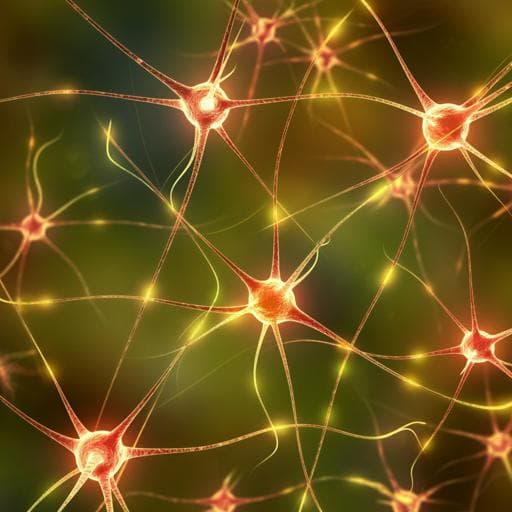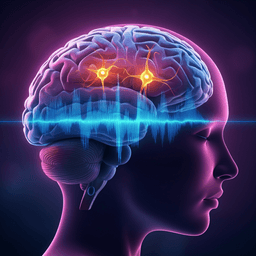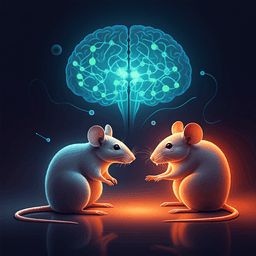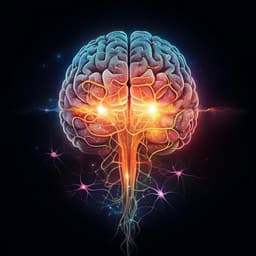
Medicine and Health
Ketamine activates adult-born immature granule neurons to rapidly alleviate depression-like behaviors in mice
R. Rawat, E. Tunc-ozcan, et al.
Explore the exciting discovery that ketamine's rapid antidepressant effects are driven by adult-born immature granule neurons (ABINs) in the mouse hippocampus. Research by Radhika Rawat, Elif Tunc-Ozcan, Tammy L. McGuire, Chian-Yu Peng, and John A. Kessler uncovers how activating and inhibiting these neurons could lead to new depression therapies.
~3 min • Beginner • English
Introduction
Major depressive disorder (MDD) imposes a major global disease burden, and most conventional antidepressants have a delayed onset of action (1–6 weeks) with limited response rates. By contrast, a single subanesthetic dose of ketamine produces antidepressant effects within hours that can persist for up to several weeks, yet its use is limited by adverse effects and abuse potential. The mechanisms underlying ketamine’s rapid action are not fully understood. Although ketamine is a non-competitive NMDA receptor antagonist, other NMDA antagonists do not consistently reproduce its antidepressant effects, suggesting additional mechanisms. Prior work implicates ketamine-induced signaling changes, including BDNF, eEF2, mTOR, and AMPAR activation; AMPAR activity in hippocampus and prefrontal cortex is required for ketamine’s behavioral effects, and the AMPAR antagonist NBQX can reverse these effects. The hippocampus, particularly the dentate gyrus (DG), has been linked to depression pathophysiology, and conventional antidepressants increase adult hippocampal neurogenesis; blocking neurogenesis impairs their efficacy in animal models. However, neurogenesis requires weeks, mismatching ketamine’s rapid effects. Acute activation of adult-born immature granule neurons (ABINs) in DG can induce rapid antidepressant-like effects, suggesting these cells may mediate ketamine’s acute actions. This study tests the hypothesis that ABIN activity is necessary and sufficient for ketamine’s rapid antidepressant-like effects.
Literature Review
The authors situate their work within findings that: (1) hippocampal circuitry, including DG, is implicated in MDD and hippocampal volume is reduced in patients; (2) chronic antidepressants enhance adult hippocampal neurogenesis and require it for behavioral efficacy in rodent and primate models; (3) ketamine’s rapid effects depend on AMPAR activity in hippocampus and mPFC, and AMPAR antagonism (NBQX) can block ketamine’s behavioral outcomes; (4) ketamine and metabolites modulate signaling pathways such as BDNF, eEF2, mTOR, and AMPAR trafficking; (5) prior reports suggested that acute activation of adult-born immature neurons can induce rapid antidepressant-like behavior, motivating a direct test of ABINs’ causal role. These lines of evidence support investigating ABIN activity as a mechanistic driver of ketamine’s rapid actions.
Methodology
Animals: Wild-type C57BL/6 mice (primarily males for ketamine/NBQX experiments) and transgenic lines enabling chemogenetic manipulation of adult-born neurons were used. Housing under 12 h light/dark; food/water ad libitum; IACUC-approved procedures.
Behavioral assays: Three-chamber social interaction test (SIT; sociability ratio) and social novelty test (SNT; novelty ratio), tail suspension test (TST; immobility time), and open field test (OFT; locomotion).
Experimental designs:
1) Ketamine activation in WT mice: Single i.p. dose ketamine (3 mg/kg; subanesthetic) or saline administered 24 h prior to behavioral testing; immediately post-testing, brains collected for analysis of neuronal activity markers.
2) Necessity of ABIN activity: Ascl1-Cre;hM4Di mice received tamoxifen (once daily ×5) to induce DREADD expression in adult-born immature granule neurons. Three weeks later, clozapine-N-oxide (CNO) or vehicle administered (i.p.), followed 2 h later by saline or ketamine; CNO/vehicle provided ad libitum overnight; behavioral tests and tissue collection followed. This was done in unstressed mice and in mice subjected to unpredictable chronic mild stress (UCMS/UCMS) for 2–3 weeks.
3) AMPAR dependency: WT mice received ketamine or saline and NBQX (10 mg/kg s.c.) or vehicle 24 h prior to testing; assessed behavior and DG activity markers.
4) Sufficiency of ABIN activity: Ascl1-Cre;hM3Dq mice received tamoxifen, then UCMS for ~3 weeks; on day 28, mice received saline, ketamine, or CNO (i.p.). After 24 h, behavioral testing and tissue collection.
Histology and markers: Immediate early genes c-Fos and EGR1 (as proxies of activity); neuronal maturity markers NeuN, Calbindin (mature), and Calretinin; HA tag to identify DREADD-expressing ABINs. Immunohistochemistry on 50 µm sagittal DG sections; quantification of EGR1+ cells, colocalization with HA/NeuN/Calb/CR; reported as cells/mm².
Statistics: Two-tailed t-tests, two-way ANOVA (with interaction terms), repeated-measures ANOVA where appropriate, and Tukey’s/Sidak’s post hoc tests. Normality assessed (Shapiro–Wilk, Kolmogorov–Smirnov). Significance threshold p < 0.05. Sample sizes indicated per figure; data shown as mean ± SEM.
Key Findings
- Ketamine rapidly improves behavior without affecting locomotion: In WT C57BL/6 mice 24 h post-dose, ketamine increased sociability (SIT) and preference for social novelty (SNT) and decreased immobility in TST vs saline (p < 0.001 for each); no change in OFT total distance.
- Ketamine increases DG neuronal activity with bias toward immature neurons: Single dose increased c-Fos and EGR1+ cells in DG (e.g., EGR1+ cells/mm² saline vs ketamine, p < 0.001). Colabeling showed a larger proportion of EGR1+ in NeuN+Calbindin− immature neurons compared with Calbindin+ mature neurons (Two-way ANOVA effects including Calb and ketamine factors; significant ketamine-induced increases in EGR1+Calb− cells; representative p-values: Calb factor p = 0.002; ketamine factor p < 0.0001; saline Calb− vs ketamine Calb− p = 0.002).
- ABIN activity is necessary for ketamine’s behavioral effects in unstressed mice: Chemogenetic inhibition of ABINs (Ascl1-Cre;hM4Di + CNO) blocked ketamine-induced increases in sociability and novelty and the decrease in TST immobility; CNO had no effect in saline-treated controls. Behavioral interactions typically showed significant ANOVA interactions with post hoc contrasts such as vehicle+ketamine vs CNO+ketamine p < 0.001.
- ABIN activity is necessary under chronic stress: In UCMS-exposed mice, ketamine rescued sociability and novelty and reduced immobility (p ≤ 0.001), but these effects were prevented by CNO-mediated ABIN inhibition (e.g., SIT two-way ANOVA interaction F(3,42)=12.76, p=0.0008; vehicle+ketamine vs CNO+ketamine ****p < 0.0001). Locomotion remained unchanged.
- Ketamine does not change ABIN numbers acutely but increases their activity: Total HA+ ABIN counts were unchanged by ketamine, whereas HA+EGR1+ double-positive ABINs increased significantly (p < 0.0001), indicating activity rather than neurogenesis drives acute effects.
- AMPAR activity is required: The AMPAR antagonist NBQX blocked ketamine’s enhancements in sociability, novelty, and reductions in immobility, and prevented ketamine-induced increases in EGR1 in DG (ANOVA interactions significant; example: SIT interaction F1,40=4.514, p=0.040; vehicle+ketamine vs NBQX+saline p=0.0003; EGR1/Calb cell quantification interaction F1,28=5.107, p=0.0330).
- ABIN activation alone is sufficient: Excitatory DREADD activation (Ascl1-Cre;hM3Dq + CNO) in ABINs mimicked ketamine’s behavioral effects after UCMS, increasing sociability and novelty and decreasing immobility (ANOVA treatment effects: SIT F2,12=12.53, p=0.002; SNT F2,12=12.92, p=0.001; TST F2,21=19.19, p < 0.0001). CNO increased HA+EGR1+ ABIN counts (p < 0.0001) without altering total HA+ or overall EGR1+ counts, paralleling ketamine’s cellular signature.
Discussion
The findings establish that the activity of adult-born immature granule neurons in the DG is a critical mediator of ketamine’s rapid antidepressant-like behavioral effects. Ketamine elevates activity predominantly in immature (Calbindin−) DG neurons and improves sociability/novelty measures and reduces behavioral despair (TST) without altering locomotion. Chemogenetic inhibition of ABINs abolishes ketamine’s benefits in both unstressed and UCMS paradigms, demonstrating necessity. Conversely, selective activation of ABINs reproduces ketamine-like behavioral and cellular changes, demonstrating sufficiency independent of changes in neuron number. Blocking AMPAR signaling with NBQX abrogates ketamine’s behavioral and cellular effects, indicating that AMPAR-dependent activity upstream of or within ABINs is required for ketamine’s actions. The work refines the mechanistic framework of ketamine’s acute antidepressant effects, focusing on a defined hippocampal cell population, and suggests that targeting ABIN activity or its inputs may recapitulate therapeutic benefits while reducing ketamine’s systemic side effects. The data also align with prior evidence that sustained ketamine effects may involve neurogenesis over longer timescales, whereas the immediate effects stem from increased activity of existing ABINs.
Conclusion
This study identifies adult-born immature granule neuron activity in the dentate gyrus as both necessary and sufficient for the rapid antidepressant-like effects of ketamine in mice. Ketamine increases activity in ABINs without changing their numbers, its effects require AMPAR signaling, and selective ABIN activation recapitulates ketamine’s behavioral outcomes. These insights highlight ABINs as a precise therapeutic target for developing rapid-acting antidepressants with fewer side effects than ketamine. Future research should localize the critical AMPAR sites (within ABINs vs upstream regions such as mPFC), map circuit-level inputs/outputs of ABINs during antidepressant responses, examine sex-specific effects, and delineate how acute ABIN activation interfaces with longer-term neurogenic changes and addiction liability.
Limitations
- Species/model limitations: Findings are in mice (including UCMS), which may not generalize to humans.
- Behavioral scope: Only select DG-dependent social and despair-related behaviors were assessed; other behavioral domains and addiction-related phenotypes were not comprehensively evaluated.
- Mechanistic localization: While AMPAR dependence is shown, the precise cellular locus (ABINs vs upstream regions like mPFC) remains unresolved.
- DREADD vs ketamine: Chemogenetic activation may not fully replicate ketamine’s network-wide effects; potential differences in downstream signaling/behavior were not exhaustively assessed.
- Sex considerations: Initial sex differences were observed; some experiments focused on males, potentially limiting generalizability across sexes.
- Activity proxies: Neuronal activity inferred from immediate-early genes (EGR1, c-Fos), which are indirect measures; sample sizes for some histological quantifications were small (e.g., n = 4 mice/group).
Related Publications
Explore these studies to deepen your understanding of the subject.







